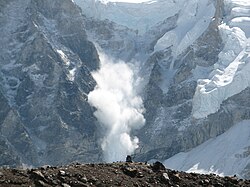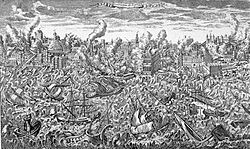Natural disaster

A natural disaster is a major event caused by the natural processes of the Earth. Examples are floods, hurricanes, tornadoes, earthquakes, volcanic eruptions, tsunamis and other geologic processes. A natural disaster causes loss of life or property damage, and leaves some economic damage afterwards costing millions.
Human activities may be the cause of some natural disasters, such as climate change , deforestation and landslides.
The damage disasters do to humans and their property counts most. There is a saying: "disasters occur when hazards meet vulnerability".[1]
If a strong earthquake happens in uninhabited areas, it is usually not seen as a disaster. An adverse event will not rise to the level of a disaster if it occurs in an area without vulnerable population. In a vulnerable area, such as Nepal during the 2015 earthquake, an earthquake can have disastrous consequences and leave lasting damage, which can take years to repair.
Volcanoes
A volcanic eruption occurs when hot materials from the Earth's interior are thrown out of a volcano. Lava, rocks, dust, and gas compounds are some and volcanic ash and kill many people. Some are quiet outflows of hot lava. Several more complex types of volcanic eruptions have been described by volcanologists. These are often named after famous volcanoes where that type of eruption has been seen. Some volcanoes may show only one type of eruption during a period of activity, while others may show a range of types in a series.
Natural Disaster Media
Economic loss risk for six natural disasters: tropical cyclones, droughts, earthquakes, floods, landslides, and volcanoes.
A landslide in San Clemente, California in 1966
A powder snow avalanche in the Himalayas near Mount Everest.
San Francisco was devastated by an earthquake in 1906
Video of lava agitating and bubbling in the volcano eruption of Litli-Hrútur, 2023
1755 copper engraving depicting Lisbon in ruins and in flames after the 1755 Lisbon earthquake. A tsunami overwhelms the ships in the harbor.
References
- ↑ Wisner B. et al. 2004 (2004). At risk - natural hazards, people's vulnerability and disasters. Wiltshire: Routledge. ISBN 0-415-25216-4.








